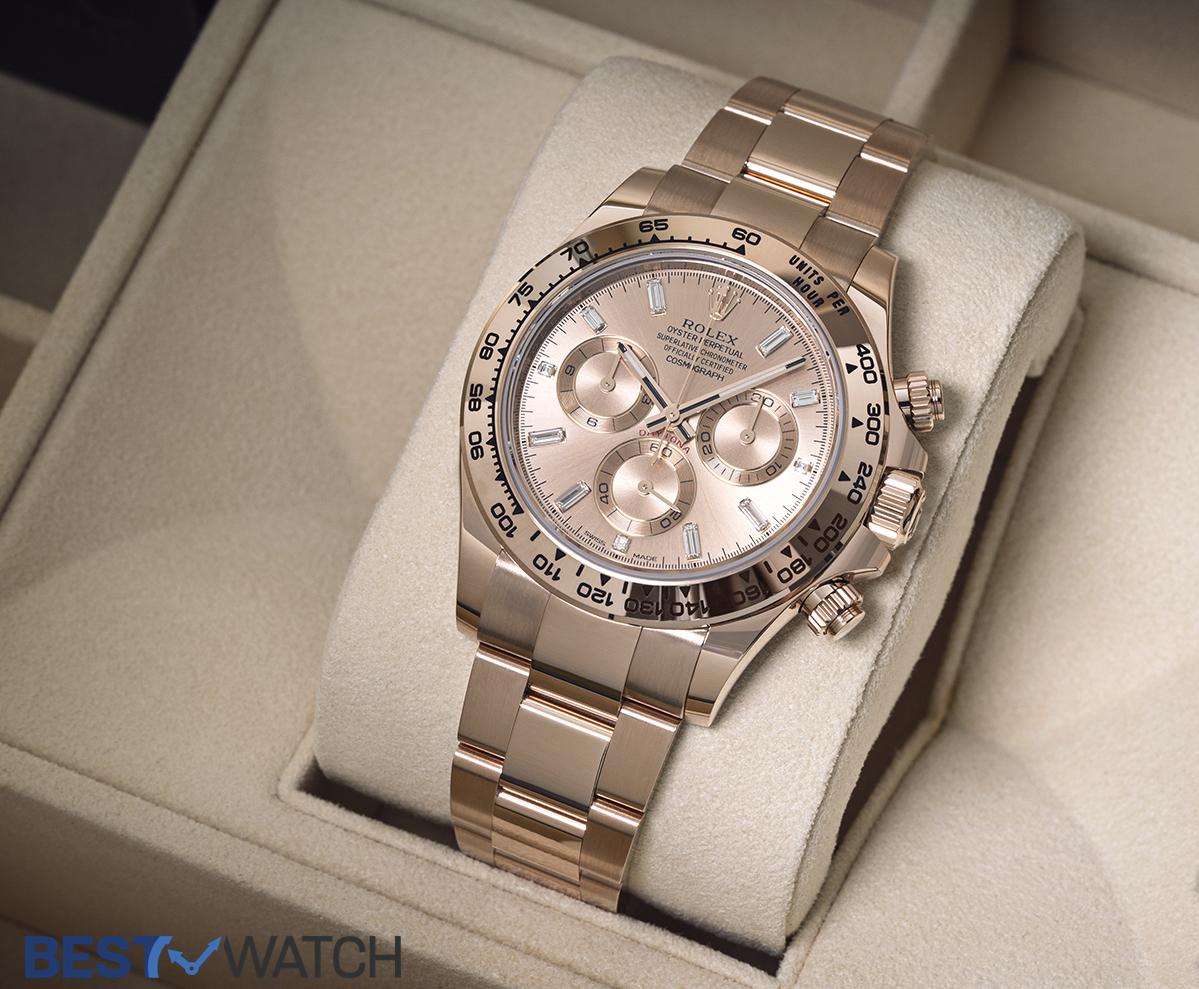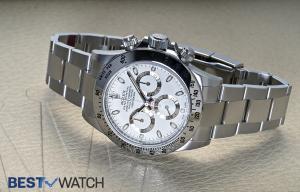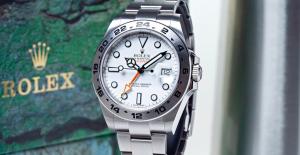
Rolex Daytona is one of the best and most admired mechanical chronograph wristwatches ever made. Primarily created for racing drivers and motorsports professionals, this sports chronograph from the celebrated Swiss watch brand has been considered as a holy grail by seasoned horology enthusiasts. Appropriately named after the famous Daytona Beach City in Florida in the United States, this iconic timepiece embodies the luxury brand’s extraordinary fervour for motor racing and fierce passion for speed.
Known simply as “Daytona,” the Rolex Oyster Perpetual Cosmograph Daytona has been renowned for its superior reliability and outstanding performance as a perfect luxury tool watch dedicated to automobile racing arena. Boasting a timeless design, this elegant yet robust chronograph graciously provides precise and efficient timekeeping functionality along with a highly legible dial and the extremely durable exterior.
Introduced in 1963, the Rolex Daytona family has been evolved tremendously all the way through three generations. The first generation models feature manual wound movements, the second series with self-winding and the third series with the Rolex’s first in-house chronograph self-winding calibre. In 2013, this iconic watch collection celebrated its 50th anniversary. In 2017, a rare vintage Rolex Daytona Paul Newman (reference 6239) surpassed the existing records and became the most expensive wristwatch sold at auction.
Daytona Beach – The “World Centre of Automobile Racing”
Ideally located in the east-central part of the U.S. state of Florida, Daytona Beach is a city with a rich heritage in motor sports. The hard-packed sand at the Daytona Beach enabled the motor sports legends to beat land-speed records. From 1903 to 1935, several attempts were made by racing enthusiasts to test their cars at the beach. The most prominent among the automobile pioneers was Sir Malcolm Campbell who achieved a top speed of 276 mph (445 km/h) at Daytona Beach with his Bluebird V.
This was the last record set on the beach in Daytona. Although the further land-speed attempts were relocated to a new site, the Bonneville Salt Flats in Utah, Daytona Beach maintained its status in automobile racing by hosting motorsports championships.
Following this longstanding tradition NASCAR (National Association for Stock Car Racing) was born in 1948 in Daytona. In the 1950s, the authorities decided to create a permanent, hard-surface racetrack for the speed races. Inaugurated in 1959, the Daytona International Speedway was the fastest racing circuit in the United States. It hosted “Daytona Continental” racing event in 1962, one year before the official launch of the Rolex Cosmograph Daytona.
From the first editions of the Daytona Continental, the winners have received a Rolex Cosmograph watch in addition to the trophy. And not long afterwards, to emphasize the Swiss watch brand’s enduring relationship with this iconic racetrack, Rolex named their chronograph model the Cosmograph Daytona.
Since 1966, the Daytona International Speedway has been hosting The Rolex 24 At Daytona® (earlier known as The 24 Hours of Daytona). It is one of the most prestigious endurance races in the world alongside the 24 Hours of Le Mans. In 1992, Rolex was appointed as the Title Sponsor of the 24 Hours of Daytona and since then this racing event has been called the Rolex 24 At Daytona®.
The Rolex Cosmograph Daytona Collection

Rolex has been producing mechanical chronograph watches since the 1930s. The early generation Rolex chronographs also incorporated auxiliary functions on the dial, such as tachymeter, telemeter or pulsometer. In 1939, the premium brand introduced the first chronograph with a waterproof Oyster case. The introduction of daytona rolex chronographs in the 1960s represents a significant milestone in the illustrious history of the most admired watch brand in the world.
The First Series
The Rolex Cosmograph Daytona was launched in 1963 as a sports tool watch dedicated to racing drivers. The Daytona models produced from 1963 until 1988 typically come under the Original (first) series. All of them had customized and modified manual wound movements based on the legendary Valjoux Calibre 72.
The Cosmograph Daytona watch shows up with a highly legible three-counter layout featuring strongly contrasting tone: black on a light coloured dial or a light colour on a black dial. Made of stainless steel or 18-carat gold, these Cosmograph watches also featured a tachymeter bezel. The notable references from the Original series are 6239, 6240, 6241,6262,6263,6264 and 6265. Depending upon the reference, Daytona featured engraved metal bezel or acrylic bezel insert. The first series models were fitted with acrylic crystal glasses.

The reference 6239 was the first Rolex model to have the ‘COSMOGRAPH’ inscription on the dial. The earliest rolex cosmograph daytona models did not feature the DAYTONA inscription. This reference also features the so-called pump pushbuttons for operating chronograph functions. Launched in 1965, the reference 6240 introduced screw-down chronograph pushers instead of the pump pushers found on the original model. This specific reference had enhanced water resistance in comparison with the first model.
Nowadays, the Original Cosmograph Daytona series models have been highly sought after by vintage watch collectors. Among them, the variants with Exotic dials are extremely rare. These variants sell for staggering prices during vintage watch auctions. They have been known as “Paul Newman” Daytonas because the legendary American film actor and racing diver Paul Newman wore one of these timepieces.

On 26th October 2017, a Rolex Daytona watch formerly owned by the actor Paul Newman was sold for US$17.75 million by Phillips in association with Bacs & Russo in New York City. It was a world record in terms of price achieved by a single wristwatch during auctions.
In November 2019, a unique Patek Philippe Grandmaster Chime watch was auctioned for US$31.19 million at the Only Watch charity event. This unique piece surpassed the record and became the most expensive wrist wristwatch ever sold at auction. As on date, the above-said paul newman daytona remains the second most expensive wristwatch ever sold at auction. In December 2020, a Rolex “Big Red” Daytona (Ref. 6263) owned by Paul Newman was sold for US $5.5 Million during RACING PULSE, Phillips’ Flagship New York Watch Auction.
The Second Series
In 1988, Rolex undertook the production of second series of Cosmograph Daytona watches. The brand equipped this new series with modified self-winding Calibre 3019PHC. This high-frequency chronograph movement was originally manufactured by Swiss brand Zenith and Rolex customized it according to its specifications. The first Daytona watch to be equipped the modified Zenith El Primero movement was the reference 16520.
Rolex replaced more than 50 per cent of the components of the Zenith Calibre 3019PHC with parts specifically designed for its movements. The resulting new calibre 4030 included an in-house oscillator with a variable inertia balance wheel, Microstella regulating nuts and a hairspring with a Breguet overcoil – as well as a self-winding module with a Perpetual rotor. The movement was systematically submitted for official COSC certification to receive the designation of the chronometer. All versions of the new model featured the “Superlative Chronometer Officially Certified” on their dial as well as “Oyster Perpetual Cosmograph Daytona”.
For the second series watches, Rolex increased the diameter of the Oyster case from 36 to 40 mm and included shoulders to protect the crown. The tachymeter bezel in metal was made wider and engraved with a 400-unit graduated scale. The dial was also modernized, while preserving its inimitable style and its signature “Daytona” in red letters.
In addition, Rolex equipped the Secind series models with sapphire crystal glass instead of the acrylic crystal of the original series. Rolex produced a number of references in this series in limited quantities until 2000. The brand used five digit reference numbers to denote the models of the second generation Daytona watches.
The Third Series

In 2000, Rolex introduced the modern generation of Cosmograph Daytona watches. The Third series is comprised of Daytonas equipped with Rolex’s first in-house self-winding chronograph movement, the Calibre 4130. The watches from the third series can be identified by their six digit reference numbers. The debut model of the new generation Rolex Daytona series was the reference 116520. This stainless steel model features stainless steel bezel engraved with tachymeter scale. In 2016, the reference 116500 replaced the Rolex Daytona 116520.
The new generation models feature some design enhancements on their dial side. For example, the two sub-dials at the 3 and 9 o’clock positions are now aligned slightly above the centre of the dial, and the small seconds has been relocated from the 9 o’clock to the 6 o’clock.
The new-generation self-winding chronograph movement – calibre 4130 – has been entirely designed and manufactured by Rolex. This extremely reliable and high-performance movement incorporates a vertical clutch to activate the stopwatch function, instead of the traditional lateral clutch. This ensures extremely precise starting, and stopping of the chronograph seconds hand as soon as the pusher is pressed. Its larger mainspring offers the power reserve to 72 hours, instead of the previous 50 hours.
The larger balance wheel, equipped with the Rolex micrometric regulating system via Microstella nuts, ensures extraordinary precision. The new Cosmograph Daytona is equipped with the Parachrom hairspring, which offers superior shock and temperature resistances as well as exceptional antimagnetic properties. It was also the first Rolex movement to bear its name engraved on the oscillating weight: a curving “Daytona” in red letters recalling the name on the dial.

The iconic brand subsequently added new references to the third generation Daytona watches. In 2001, the new generation bicolor Rolex Daytona reference 116523 made of stainless steel and 18 carat yellow gold was introduced. Rolex launched an 18 ct EVEROSE gold version with Monobloc black CERACHROM in 2011, and in the following year, the Cosmograph Daytona Jewel variant was introduced. The innovative CERACHROM bezel of the above-mentioned rose gold Daytona watch was developed in house by Rolex.

In 2013, celebrating the 50th anniversary of the Daytona family, Rolex released a special edition Platinum version. This anniversary edition has been equipped with a chestnut brown monobloc Cerachrom bezel and an ice blue dial. In 2014, Rolex introduced 116576 TBR, a jewellery version featuring platinum case, diamond paved dial and baguette-cut diamond set bezel. In 2016, the brand introduced reference 116500ln, the new Cosmograph daytona panda version in stainless steel case and fitted with a black Cerachrom bezel. In 2017, Rolex introduced three new Cosmograph Daytona versions in 18 ct yellow, white or Everose gold. All these new versions feature monobloc Cerachrom bezel in black ceramic. In 2018, Rolex added a gem-set version of the 18 ct Everose gold Daytona watch. A gem set version of the 18 ct yellow gold Daytona watch was released in 2019.
Conclusion

Although a much sought-after collection, the Cosmograph Daytona watches are extremely rare to find in the market. Rolex typically follow a strict limited production strategy for this prominent family of valuable watches. So, it requires longer waiting periods to acquire one via authorized dealers.
It is one of the most preferred wristwatches for investment purpose. The Original Series Daytona watches manufactured from 1963 to 1988, especially the Exotic dial variants come with astounding price tags due to their rarity and the incredible stories (And some mysteries!) associated with them. Typically, a watch with an incredible history persuades more admirers. For example, the subtle features that distinguishes an “Exotic” or “Paul Newman” variant from a conventional Daytona model are some minor differences in their dial and counters.
It is to be noted that Rolex never officially used the Paul Newman designation to denote their “Exotic” dial variants. This expression has been used by the ardent admirers as Paul Newman had an “Exotic” dial version of the Daytona watch. Due to this link up with the renowned film star, the so-called “Paul Newman” variants attracts wealthy watch collectors who are ready to spend huge amounts to acquire rare and celebrated wristwatches.
Interestingly, when it was launched in 1963, the Cosmograph Daytona had a retail price of US$ 300 only. Today, depending upon the rarity and vintage value, a Cosmograph Daytona watch can cost from tens of thousands of dollars to multi-million dollars. Their record-breaking achievements during the prestigious auctions certify the investment potential of Cosmograph Daytona watches.
The mind-blowing transition of Cosmograph Daytona from a tool watch for racing divers to the world’s most preferred luxury steel chronograph is a major triumph in the history of Rolex. This impressive chronograph collection will always remain as an ultimate icon representing the superior watchmaking traditions.



Leave A Reply
Your email address will not be published.
Thank you for your comments
We have received your comment and it is being processed.Oops, Something Went Wrong
Please try again later.